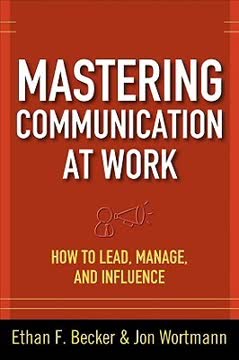Key Takeaways
1. Master Communication by Matching Your Listener's Tendency
Master communicators are able to change the way they communicate so that they meet the needs of the person with whom they are speaking, and, most importantly, they are comfortable changing the way they communicate.
Inductive vs. Deductive. People process information differently, either inductively (details first) or deductively (point first). Recognizing this is the first step to effective communication. Inductive thinkers need a narrative, a story, and the details before they can understand the point. Deductive thinkers, on the other hand, want the bottom line upfront and then the supporting details.
Adapt your style. The key is to identify your listener's tendency and adapt your communication style accordingly. This involves consciously adjusting the order in which you present information, whether it's leading with the conclusion or building up to it through a series of details. This is not about changing who you are, but about being a stronger communicator.
Benefits of matching. Matching your listener's tendency builds trust and rapport, ensuring your message is received and understood. It also demonstrates that you value their perspective and are willing to meet them where they are, fostering a more collaborative and productive relationship.
2. Manage Your Ethos to Build Credibility and Influence
Your ethos is relative—it changes based on who you are with and the environment you are in.
Ethos defined. Ethos, or credibility, is a crucial element of effective communication. It's not just about what you say, but who you are and how you are perceived. Ethos is a synthesis of your accomplishments, behaviors, appearance, and the reputation of the organizations you represent.
Factors influencing ethos:
- Culture
- Thinking style
- Listening and speaking habits
- Organization
- Title
- Past experience
- Expertise
- Relationships
- Appearance
- Results
Managing your ethos. To manage your ethos, discern how you are perceived, identify the ethos you need to achieve your goals, and then adopt behaviors that demonstrate that ethos. This involves adapting your communication style, appearance, and actions to align with the expectations of your audience and environment.
3. Motivate Others by Speaking to Their Individual Drivers
Discover what drives them, and they will take ownership of their projects and even love what they’re doing.
The Motivation Matrix. People are motivated by different things, either ethos, emotion, or logic, and for different reasons, either achievement, recognition, or power. Understanding these individual drivers is key to effective motivation.
Motivation by:
- Ethos: Driven by credibility and authority
- Emotion: Driven by excitement, urgency, or passion
- Logic: Driven by reason and practicality
Motivation for:
- Achievement: Driven by completing tasks and meeting goals
- Recognition: Driven by public praise and acknowledgment
- Power: Driven by control, authority, and decision-making
Tailor your approach. To motivate others, identify their primary drivers and tailor your language and tone to resonate with their individual needs. This involves crafting messages that appeal to their sense of ethos, emotion, or logic, and that offer them the achievement, recognition, or power they seek.
4. Frame Your Message to Focus Listeners' Attention
Leaders and managers too often say things that send the wrong message and unintentionally bring up topics that distract their teams.
Framing defined. Framing is the art of choosing words and phrases to shape your listener's perception and focus their attention. It involves intentionally selecting language that emphasizes certain aspects of your message while minimizing distractions.
Key elements of framing:
- Identify the point
- Anticipate distractions
- Choose vocabulary and imagery carefully
- Prepare frames in advance
Benefits of effective framing. Effective framing ensures your message is clear, memorable, and persuasive. It also helps to build trust and rapport by demonstrating that you understand your listener's perspective and are communicating with their needs in mind.
5. Validate Others to Build Strong Relationships
Validation is much more than a pat on the back.
Validation defined. Validation is acknowledging and appreciating another person's participation and contributions. It's about making them feel heard, understood, and valued.
Forms of validation:
- Active listening
- Paraphrasing
- Asking meaningful questions
- Sharing stories of their success
- Using positive body language
Benefits of validation. Validation builds trust, strengthens relationships, and fosters a more collaborative and productive environment. It also encourages open communication and makes it easier to deliver constructive feedback.
6. Add Color to Your Speech to Emphasize Meaning
If you cannot strategically change your tone so that it matches your intended message, the person who can will beat you even if your ideas are better.
Adding color defined. Adding color is about using vocal techniques to emphasize meaning and engage your listeners. It involves consciously manipulating elements like speed, volume, stress, and inflection to create a more dynamic and impactful delivery.
The Four Horsemen of Delivery:
- Speed: Varying the rate and pace of your speech
- Volume: Adjusting the loudness or softness of your voice
- Stress: Emphasizing certain words or syllables
- Inflection: Raising or lowering your pitch
Matching tone to message. The key is to ensure your tone aligns with the content of your message. A serious topic requires a serious tone, while an exciting topic calls for enthusiasm. This creates authenticity and strengthens your connection with your audience.
7. Defuse Defensiveness with Validation and Understanding
If your listeners are defensive, your message will most likely be lost.
Defensiveness as a barrier. Defensiveness prevents clear communication and hinders collaboration. When people feel attacked or threatened, they become focused on protecting themselves rather than listening to your message.
Defensive Persuasion Format:
- Validate: Acknowledge their perspective and feelings
- Frame: Clearly state your message and desired outcome
- Decide your timeline: Be patient and persistent
Strategies for defusing defensiveness:
- Active listening
- Empathy
- Non-judgmental language
- Finding common ground
By validating their perspective and creating a safe space for dialogue, you can help them overcome their defensiveness and become more receptive to your message.
8. Structure Meetings for Clarity and Productivity
A meeting without a facilitator is like a war without a general.
Meetings as arenas. Meetings should be structured environments where ideas can be debated, brainstormed, and challenged constructively. The goal is to create a space where participants feel safe to express their opinions and engage in productive dialogue.
The Meeting Format:
- Have someone facilitate
- Set the time frame
- Clarify the purpose
- Set the ground rules for the conversation
- Determine the type of conversation
- Agree on the next steps
Types of conversations:
- Debate
- Brainstorming
- Informational
- Venting
- Decision making
By following a clear format and establishing ground rules, you can ensure that meetings are focused, productive, and respectful of everyone's time.
9. Hire for Fit by Assessing Character and Talent
You need someone whom your colleagues will be really happy to have on their team and who will make everyone’s lives better.
Beyond technical skills. Hiring is about more than just finding someone who can perform the job functions. It's about finding someone who fits your team's culture, values, and communication style.
Key elements of assessing fit:
- Intention: What are their long-term goals?
- Capabilities: What are their strengths and weaknesses?
- Stage of your business: Do they thrive in a startup or established company?
- Hierarchy: Do they prefer structure or autonomy?
- Communication tendencies: Are they inductive or deductive, internal or external?
- Attitude: Do their beliefs align with your organization's values?
Creating a comfortable environment. To assess fit accurately, create a comfortable interview environment where candidates feel safe to be themselves. This involves asking open-ended questions, actively listening to their responses, and sharing your own experiences and perspectives.
10. Delegation Requires Clear Expectations and Support
If you manage, at some point you’ve said, “I tell them what to do, and it never gets done by the deadline.”
Delegation defined. Delegation is the art of assigning tasks and responsibilities to others in a way that empowers them to succeed. It's about more than just giving instructions; it's about setting clear expectations, providing adequate support, and fostering a sense of ownership.
The Delegation Format:
- Frame the objective
- Match tasks and capabilities
- Be explicit about limitations
- Bandwidth
- The deadline
- Support them
Benefits of effective delegation. Effective delegation frees up your time, develops your team's skills, and increases overall productivity. It also fosters a sense of trust and empowerment, leading to higher levels of engagement and motivation.
11. Deliver Criticism Constructively to Improve Performance
Criticism is communicating about the need to change behaviors.
Criticism defined. Criticism is communicating about the need to change behaviors. When done well, it improves performance and strengthens relationships. When done poorly, it damages trust and demotivates your team.
The Criticism Format:
- Cite the specific behavior
- Cite the result of the behavior
- Cite the desired correct behavior
- Your criteria for judgment
- Cite the consequences of repeat behavior
Key principles of effective criticism:
- Be direct and specific
- Focus on behavior, not personality
- Provide clear expectations
- Offer support and guidance
By following a structured format and delivering criticism with empathy and respect, you can help your team members improve their performance and reach their full potential.
12. Communication is a Hard Skill
Organizations like Google, Harvard, and the White House hire, train, and elevate people who master communication.
Communication as a core competency. Effective communication is not just a soft skill; it's a hard skill that is essential for success in any organization. It's about more than just being articulate; it's about understanding how people think, building relationships, and influencing behavior.
Creating a culture of communication:
- Prioritize communication from the top down
- Provide training and resources
- Encourage open dialogue and feedback
- Recognize and reward effective communicators
Benefits of a strong communication culture. A strong communication culture fosters trust, collaboration, and innovation. It also leads to higher levels of employee engagement, productivity, and overall organizational success.
Last updated:
Review Summary
Mastering Communication at Work receives mixed reviews, with an average rating of 3.70 out of 5. Readers appreciate its practical advice and techniques for improving workplace communication, particularly for new professionals. Some find the content basic or impractical, while others praise its clarity and applicability. The book covers topics like adapting communication styles, framing messages, and handling difficult conversations. Criticisms include rehashing existing material and potentially making readers appear inexperienced if applied too literally. Overall, it's considered a useful resource for those seeking to enhance their communication skills.
Similar Books










Download PDF
Download EPUB
.epub digital book format is ideal for reading ebooks on phones, tablets, and e-readers.




